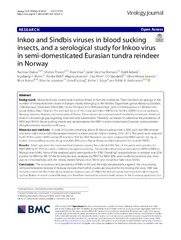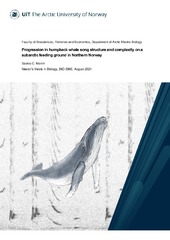Institutt for arktisk og marin biologi: Nye registreringer
Viser treff 581-600 av 2086
-
Inkoo and Sindbis viruses in blood sucking insects, and a serological study for Inkoo virus in semi-domesticated Eurasian tundra reindeer in Norway
(Journal article; Tidsskriftartikkel; Peer reviewed, 2022-06-03)Background: Mosquito-borne viruses pose a serious threat to humans worldwide. There has been an upsurge in the number of mosquito-borne viruses in Europe, mostly belonging to the families Togaviridae, genus Alphavirus (Sindbis, Chikungunya), Flaviviridae (West Nile, Usutu, Dengue), and Peribunyaviridae, genus Orthobunyavirus, California serogroup (Inkoo, Batai, Tahyna). The principal focus of this ... -
Micro- and macro-habitat selection of Atlantic salmon, (Salmo salar), post-smolts in relation to marine environmental cues
(Journal article; Tidsskriftartikkel; Peer reviewed, 2022-04-20)Atlantic salmon is an economically and culturally important species. The species encounters several natural and man-made threats during its migration between fresh water and the ocean, which in combination may explain its ongoing decline. With the aim to better understand whether post-smolt behaviour is influenced by physical oceanographic conditions, the migratory behaviour of 173 post-smolts in a ... -
Cercariae of a Bird Schistosome Follow a Similar Emergence Pattern under Different Subarctic Conditions: First Experimental Study
(Journal article; Tidsskriftartikkel; Peer reviewed, 2022-06-03)The emergence of cercariae from infected mollusks is considered one of the most important adaptive strategies for maintaining the trematode life cycle. Short transmission opportunities of cercariae are often compensated by periodic daily rhythms in the cercarial release. However, there are virtually no data on the cercarial emergence of bird schistosomes from freshwater ecosystems in northern ... -
The Sub-Ice Algal Communities of the Barents Sea Pack Ice: Temporal and Spatial Distribution of Biomass and Species
(Journal article; Tidsskriftartikkel; Peer reviewed, 2022-01-27)This work summarizes ice algal studies, presented as biomass and species temporal and spatial distribution, during 11 cruises conducted between 1986 and 2012. The majority of the biomass was found as loosely attached sub-ice algal layers, and sampling required diving. A maximum of 40 mg chlorophyll m<sup>−2</sup> and 15.4 × 10<sup>9</sup> cells m<sup>−2</sup> was measured in May. The species ... -
Contributions and perspectives of Indigenous Peoples to the study of mercury in the Arctic
(Journal article; Tidsskriftartikkel; Peer reviewed, 2022-06-11)Arctic Indigenous Peoples are among the most exposed humans when it comes to foodborne mercury (Hg). In response, Hg monitoring and research have been on-going in the circumpolar Arctic since about 1991; this work has been mainly possible through the involvement of Arctic Indigenous Peoples. The present overview was initially conducted in the context of a broader assessment of Hg research organized ... -
Progression in humpback whale song structure and complexity on a subarctic feeding ground in Northern Norway
(Master thesis; Mastergradsoppgave, 2021-08-16)Male humpback whales (Megaptera novaeangliae) sing structurally complex songs traditionally associated with low latitude breeding grounds. This vocal behaviour is increasingly reported outside these areas. All singers in a given population sing the same version of a song that is constantly evolving with modifications on different levels within the song structure. This study provides the first detailed ... -
Modelling the effect of submarine iceberg melting on glacier-adjacent water properties
(Journal article; Tidsskriftartikkel; Peer reviewed, 2022-04-07)The rate of ocean-driven retreat of Greenland’s tidewater glaciers remains highly uncertain in predictions of future sea level rise, in part due to poorly constrained glacier-adjacent water properties. Icebergs and their meltwater contributions are likely important modifiers of fjord water properties, yet their effect is poorly understood. Here, we use a 3-D ocean circulation model, coupled to ... -
Sustainable management of populations impacted by harvesting and climate change
(Journal article; Tidsskriftartikkel; Peer reviewed, 2022-01-13)The sustainable use of natural resources is critical for addressing the global challenges of today. Strategies for sustainable harvesting need to consider not only harvested species, but also other non-harvested species interacting with them in the same ecosystem. In addition, environmental variation needs to be considered, with climate change currently being one of the main sources of this ... -
Somatic Dimorphism in Cercariae of a Bird Schistosome
(Journal article; Tidsskriftartikkel; Peer reviewed, 2022-02-24)Phenotypic polymorphism is a commonly observed phenomenon in nature, but extremely rare in free-living stages of parasites. We describe a unique case of somatic polymorphism in conspecific cercariae of the bird schistosome Trichobilharzia sp. “peregra”, in which two morphs, conspicuously different in their size, were released from a single Radix balthica snail. A detailed morphometric analysis ... -
Early Evolutionary Selection of NAD Biosynthesis Pathway in Bacteria
(Journal article; Tidsskriftartikkel; Peer reviewed, 2022-06-21)Bacteria use two alternative pathways to synthesize nicotinamide adenine dinucleotide (NAD) from nicotinamide (Nam). A short, two-step route proceeds through nicotinamide mononucleotide (NMN) formation, whereas the other pathway, a four-step route, includes the deamidation of Nam and the reamidation of nicotinic acid adenine dinucleotide (NAAD) to NAD. In addition to having twice as many enzymatic ... -
Overview of the MOSAiC expedition- Atmosphere
(Journal article; Tidsskriftartikkel; Peer reviewed, 2022-02-07)With the Arctic rapidly changing, the needs to observe, understand, and model the changes are essential. To support these needs, an annual cycle of observations of atmospheric properties, processes, and interactions were made while drifting with the sea ice across the central Arctic during the Multidisciplinary drifting Observatory for the Study of Arctic Climate (MOSAiC) expedition from October ... -
Fôring av reinsdyr – og fôringsrelaterte sykdommer
(Research report; Forskningsrapport, 2022) -
Resource partitioning may limit interspecific competition among Arctic fish species during early life
(Journal article; Tidsskriftartikkel; Peer reviewed, 2022-02-28)Arctic cod (Boreogadus saida) strongly dominates the ichthyoplankton assemblages of High Arctic seas, hence competition with other native species seldom has been studied. Yet, interspecific competition could negatively impact the survival of early life stages of fishes in Arctic areas where higher diversity prevails. We surveyed the ichthyoplankton community of the Greenland Sea, in August–September ... -
Forage fish as a predator: summer and autumn diet of Atlantic herring in Trinity Bay, Newfoundland
(Journal article; Tidsskriftartikkel; Peer reviewed, 2022-04-28)Atlantic herring (Clupea harengus; hereafter herring) is a forage fish that transfers energy from lower to higher trophic levels and sustains high-volume fisheries in the North Atlantic. This study aims to improve our understanding of the ecology of Newfoundland herring and its vulnerability to climate change by identifying key prey items and describing adult herring feeding strategies. We compared ... -
A risk assessment review of mercury exposure in Arctic marine and terrestrial mammals
(Journal article; Tidsskriftartikkel; Peer reviewed, 2022-03-16)There has been a considerable number of reports on Hg concentrations in Arctic mammals since the last Arctic Monitoring and Assessment Programme (AMAP) effort to review biological effects of the exposure to mercury (Hg) in Arctic biota in 2010 and 2018. Here, we provide an update on the state of the knowledge of health risk associated with Hg concentrations in Arctic marine and terrestrial mammal ... -
New distribution records of kelp in the Kitikmeot Region, Northwest Passage, Canada, fill a pan-Arctic gap
(Journal article; Tidsskriftartikkel; Peer reviewed, 2022-03-01)Kelps play important roles in ecosystems as they provide structural habitat and protection, and supply food. Given these beneficial roles and observed increases in seaweed biomass and distribution ranges across the Arctic, mapping kelp occurrence around Arctic coasts is both timely and necessary for future conservation. Here, we fill spatial gaps in the knowledge of kelp distribution in the southern ... -
Turbid Arctic Coastal Waters: Potential Hotspots for Primary Productivity. Riverine Influence on Microbial Productivity in high Arctic Fjords
(Master thesis; Mastergradsoppgave, 2022-05-16)The coastal domain of the Arctic is in rapid change with shifts in discharge phenology and catchment characteristics. Riverine discharge shapes hydrography, under water light climate, and nutrient dynamics during the brief melt season. Nutrients transported from catchment to coast can stimulate primary productivity, yet light attenuation caused by high surface turbidity is considered a limiting ... -
Genetic diversity and differentiation of velvet belly lanternshark (Etmopterus spinax) in the Northeast Atlantic
(Master thesis; Mastergradsoppgave, 2022-06-15)Deep-sea sharks are little resilient to targeted harvesting and bycatch fisheries due to their life history strategy characterized by slow growth, late sexual maturity, low fecundity, and few offspring. The Northeast Atlantic component of Etmopterus spinax is an example of a species where substantial population changes in terms of abundances have occurred due to intensive fisheries induced mortality. ... -
Fear towards the four large carnivores in Norway; a geospatial survey from 2010 and 2019
(Master thesis; Mastergradsoppgave, 2022-06-05)Abstract Through the last centuries it has become high disturbances and interventions in natural areas, which has forced wildlife to interact with humans. This has led to human-wildlife conflicts (HWC), where animals have become a threat to peoples’ safety or livelihood. These conflicts have often ended with species becoming endangered or extinct globally, including Norway. There are small populations ... -
Movements and diving behavior of humpback whales in relation to the capelin distribution in the Barents Sea
(Master thesis; Mastergradsoppgave, 2022-05-16)Humpback whales (Megaptera novaeangliae) are a cosmopolitan species, migrating between their mid- and high latitude foraging- and low latitude breeding grounds. Of these, the Northeast Atlantic (NEA-) population cover the longest migration distance of all mammals that last up to half a year. On the foraging grounds they feed extensively throughout the summer until early winter to gain enough energy ...


 English
English norsk
norsk


















